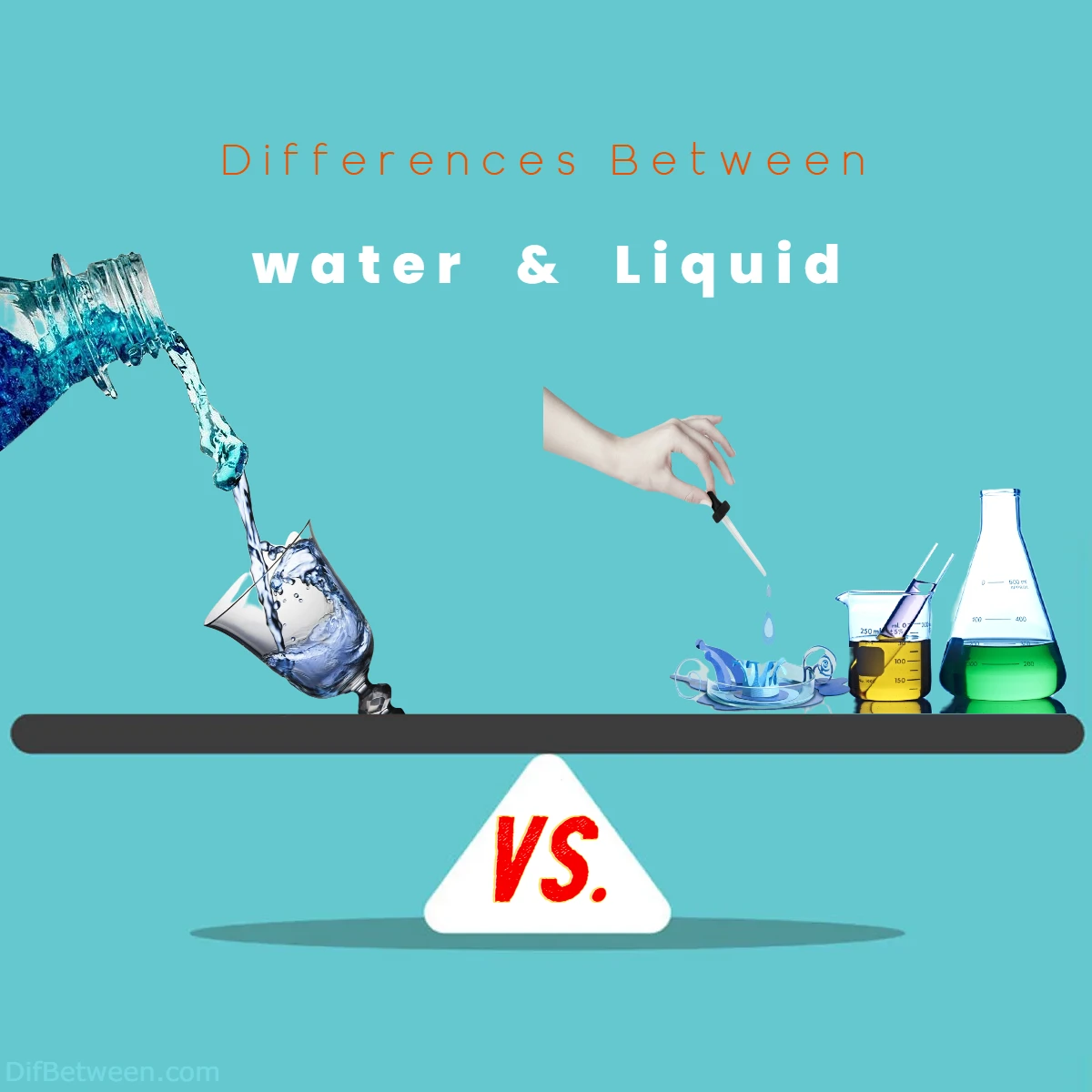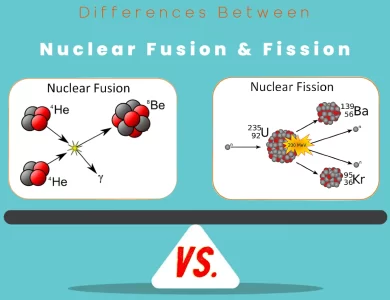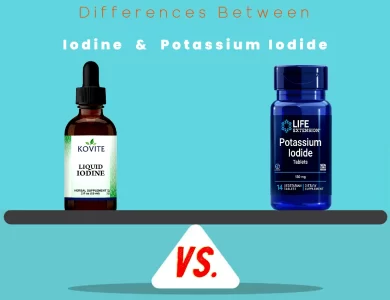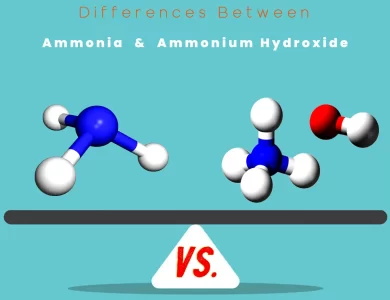
| Aspect | Water | Liquid |
|---|---|---|
| Definition | Chemical compound with two hydrogen atoms and one oxygen atom (H₂O). | One of the three classic states of matter, characterized by fluidity and ability to conform to the shape of its container. |
| Composition | Composed of hydrogen and oxygen atoms in a fixed ratio of 2:1. | Can encompass a wide range of chemical compositions, including water, but also various substances such as oils, alcohols, and more. |
| Physical State | Can exist as a solid (ice), liquid (water), or gas (vapor/steam) depending on temperature and pressure. | Refers specifically to the liquid state of matter, distinct from solids and gases. |
| Properties | – Universal solvent due to its polarity and hydrogen bonding ability. – High heat capacity, moderating temperature on Earth. – Surface tension, allowing insects to walk on water. – Essential for sustaining life. | – Exhibits fluidity, flowing freely and taking the shape of its container. – Varies in viscosity, impacting how liquids pour and interact with other substances. – Conformity to container, allowing liquids to be easily poured and transported. |
| Examples | Water in its liquid state is the most common example. | Includes a vast array of substances beyond water, such as oil, alcohol, milk, juices, and more. |
| Hydration and Health | Essential for human hydration and bodily functions, making up a significant portion of the human body. | Various liquids contribute to hydration, but water remains the primary and healthiest choice for staying hydrated. |
| Role in Nature | – Hydrological cycle, maintaining ecosystems and weather patterns. – Essential for aquatic life and habitats. – Erosion and landscape formation over geological timescales. | – Found in various forms across nature, including oceans, lakes, rivers, and more. – Important for industrial processes, thermodynamics, and healthcare. |
| Environmental Impact | – Water conservation crucial due to resource scarcity and climate change.<br> – Pollution and proper management are significant concerns. | – Proper disposal and management of liquids other than water are essential to prevent soil and water pollution. |
| Cultural and Symbolic Significance | Symbolizes life, purity, and cleansing in various cultures. Used metaphorically in literature and expressions. | Metaphors and idioms involving liquids reflect human experiences and emotions. Culinary symbolism and artistic representations. |
| Beyond Earth | Water is essential for life as we know it and a focus in astrobiology.<br> Liquid water not confirmed on other planets. | The concept of liquids is explored beyond Earth, with methane seas on Saturn’s moon Titan and subsurface oceans on Jupiter’s moon Europa. |
| Philosophical Reflections | Represents change, unity, and adaptation in philosophical contexts. Symbolizes impermanence and interconnectedness. | Serves as a metaphor for life’s flux, adaptability, and unity. Reflects the interconnectedness of human experiences. |
| Artistic Expressions | Often depicted in various art forms, from paintings to photography, due to its captivating properties. | Artistic use of liquids goes beyond water, with mediums like glass artistry and liquid-centered techniques in various forms of art. |
| Technological Innovations | – Essential for biological processes and sustenance. – Serves as a coolant and heat moderator in industrial and natural processes. | – Used in medical diagnostics and treatments. – Innovative concepts explore liquid-based computing and space propulsion. |
Water, the elixir of life, beckons us with its universal appeal, encompassing oceans, rivers, and the very essence of hydration in our bodies. On the other hand, the term “liquid” casts a wider net, embracing a spectrum of substances that flow and adapt, from oils and juices to the mesmerizing dance of molten glass. It’s like comparing the star of the show, water, with the entire ensemble, the liquids, each with its unique role to play.
Differences Between water and Liquid
The main differences between water and liquid lie in their definitions and characteristics. Water, scientifically denoted as H₂O, is a specific chemical compound with two hydrogen atoms bonded to an oxygen atom. It can exist in various states—solid (ice), liquid (water), and gas (vapor/steam)—depending on temperature and pressure. On the other hand, “liquid” is a broader term encompassing one of the classic states of matter, characterized by its fluidity and ability to take the shape of its container. While water is a prime example of a liquid, the term “liquid” also includes a diverse range of substances, such as oils, juices, and more. In essence, water is a specific type of liquid, and liquids encompass a wide array of substances with varying chemical compositions and properties.
Defining Water and Liquid
Water: The Elixir of Life
At the heart of this investigation lies “water” – a quintessential compound that’s not only essential for sustaining life but also occupies a paramount place in our collective consciousness. Water, chemically denoted as H₂O, is a molecule comprising two hydrogen atoms covalently bonded to a single oxygen atom. It is the cornerstone of existence, covering approximately 71% of Earth’s surface and constituting a significant portion of most living organisms.
Liquid: The Shape-shifting State of Matter
Now, let’s shift our attention to the broader term “liquid.” A liquid is one of the three classic states of matter, the others being solid and gas. It refers to a substance that flows freely and assumes the shape of its container. In the molecular realm, liquids exhibit a higher degree of molecular movement compared to solids, allowing them to flow and adapt to their surroundings.
Distinguishing Characteristics
Water: More than Meets the Eye
Water, with its remarkable properties, is a testament to the marvels of chemistry and physics. Here are some of its key characteristics:
| Property | Description |
|---|---|
| Universal Solvent | Water’s polarity and ability to form hydrogen bonds make it an unparalleled solvent, dissolving a wide array of substances. This property is crucial for biological processes and the water cycle. |
| High Heat Capacity | Water’s ability to absorb and retain heat moderates temperature on Earth, preventing rapid fluctuations that could be detrimental to life. It buffers temperature changes in both living organisms and their environments. |
| Surface Tension | The cohesive forces between water molecules give rise to surface tension, allowing some insects, like water striders, to walk on water. Surface tension also contributes to capillary action, aiding in the movement of water in plants and soils. |
Liquid: Adaptable and Versatile
Liquid, as a state of matter, encapsulates a variety of substances beyond just water. Its defining characteristics include:
| Property | Description |
|---|---|
| Fluidity | Liquids exhibit the ability to flow and take the shape of their containers due to the relative freedom of movement of their molecules. This property is in contrast to solids, which maintain their shape and volume. |
| Viscosity | Viscosity measures a liquid’s resistance to flow. Some liquids, like honey, have high viscosity, while others, like water, have low viscosity. This property impacts how liquids pour and interact with other materials. |
| Conformity to Container | Liquids lack a fixed shape and take the form of their container. This property is what allows liquids to be easily poured and transported. |
The Interplay of Water and Liquid in Nature
Water’s Dance in the Liquid Realm
In the grand theater of nature, water takes center stage as the prima donna of liquids. Its unique properties play an irreplaceable role in shaping the planet and supporting life:
- Hydrological Cycle: Water’s ability to transition between solid, liquid, and gaseous states fuels the hydrological cycle. Evaporation, condensation, and precipitation enable the movement of water across the globe, replenishing ecosystems and maintaining the delicate balance of Earth’s ecosystems.
- Aquatic Ecosystems: Oceans, lakes, rivers, and streams teem with life, thanks to water’s role as a habitat and medium for countless organisms. The temperature-moderating effects of water also prevent drastic shifts that could harm aquatic life.
- Erosion and Sculpting: Over millennia, water’s persistent flow has carved intricate landscapes, shaping valleys, canyons, and coastlines. It serves as nature’s sculptor, etching the Earth’s surface with its liquid touch.
Beyond Water: Diversity in Liquidity
While water’s prominence is undeniable, let’s not overlook the vast realm of other liquids that influence our daily lives:
- Industrial Applications: Liquids such as oil, gasoline, and various chemicals are the lifeblood of modern industries. From fueling transportation to manufacturing products, these liquids drive progress.
- Thermodynamics: Liquid state is central to thermodynamics – the study of energy transformation. Liquid substances are frequently employed in heat exchange systems, crucial for heating, cooling, and generating electricity.
- Medical Marvels: Pharmaceuticals, syrups, and intravenous fluids are examples of liquids that have revolutionized healthcare. They allow precise dosing and efficient delivery of medications to patients.
Water and Liquid – A Symbiotic Relationship
Hydration: Water’s Lifelong Mission
It’s impossible to discuss liquids without highlighting water’s fundamental role in sustaining life through hydration. The human body, for instance, is composed of approximately 60% water, emphasizing its vital importance. From facilitating cellular processes to regulating body temperature, water is the elixir that keeps the physiological machinery running smoothly.
Liquids as Allies of Hydration
While water is the champion of hydration, a diverse range of liquids contributes to our overall fluid intake. Beverages such as herbal teas, fruit juices, milk, and even caffeinated drinks can supplement our hydration needs. However, it’s essential to note that not all liquids are created equal. Some beverages, laden with sugars and artificial additives, may not confer the same benefits as pure water or healthier alternatives.
The Environmental Essence of Water and Liquids
Water Conservation: A Global Imperative
In an era marked by climate change and resource scarcity, the conservation of water has emerged as a pressing global concern. As we strive to ensure equitable access to clean water for all living beings, our understanding of water’s significance becomes paramount.
Liquid Byproducts and Ecological Impact
Beyond water, the production and disposal of various liquids can significantly impact the environment. From industrial waste to household runoff, improperly managed liquids can pollute soil and water bodies, compromising ecosystems and human health. Recognizing this, sustainable practices, including proper waste disposal and recycling, are pivotal in minimizing the ecological footprint of liquids other than water.
Fluid Identity – Water and Liquid in Everyday Language
Metaphorical Streams: Expressions of Language
The influence of water and liquids extends beyond the realm of science and spills over into our everyday language. Metaphors and idioms inspired by these entities often carry profound meanings that resonate with human experiences:
- “Still Waters Run Deep”: This adage reflects the idea that calm and quiet individuals may possess profound thoughts and emotions beneath their serene exteriors. Just like still water conceals its depths, people’s inner complexities might not be immediately apparent.
- “Oil on Troubled Waters”: This saying refers to the act of calming a tense situation. Just as oil can smooth the surface of turbulent waters, diplomatic gestures or soothing words can pacify conflicts.
- “Blood Is Thicker Than Water”: Often used to emphasize the significance of family bonds, this phrase suggests that relationships formed by shared experiences hold more weight than superficial connections.
Culinary Chronicles: Water and Liquid in Gastronomy
The culinary world showcases the diverse roles of liquids, particularly water, in preparing and enhancing food:
- Boiling and Steaming: Water’s ability to boil and turn into steam is the foundation of cooking methods like boiling and steaming. These techniques gently cook food while preserving its nutrients and flavors.
- Infusion and Extraction: Liquids like oil, vinegar, and alcohol are used to infuse flavors into dishes. Think of aromatic olive oil infusions or vanilla extract adding depth to baked goods.
- Sauces and Gravies: The magic of liquid thickening agents like roux (flour and fat mixture) or cornstarch transforms meat juices or broth into luscious sauces and gravies.
Liquid Realms – Exploring Beyond Earth
Water Beyond the Blue Planet
As we venture beyond Earth, water remains an object of intense fascination. Though currently undiscovered on other planets, the search for extraterrestrial water is a key aspect of astrobiology. The presence of liquid water is often considered a prerequisite for life as we know it.
Alien Oceans and Titan’s Seas
While Earth boasts vast oceans, other celestial bodies also hold liquid treasures:
- Jupiter’s Moon Europa: This moon is believed to have a subsurface ocean beneath its icy crust. Scientists speculate that hydrothermal vents on the ocean floor could offer an environment conducive to life.
- Saturn’s Moon Titan: Titan’s frigid surface hides lakes and rivers of liquid methane and ethane. While vastly different from Earth’s water, these features underscore the diversity of liquids in the cosmos.
The Philosophical Essence – Water, Liquid, and Existence
Transcending Physical Form
Water and liquids can serve as powerful metaphors for philosophical concepts and existential contemplation:
- Change and Impermanence: Just as a flowing river is never the same from one moment to the next, life is in a constant state of flux. Water’s mutable nature reflects the impermanence of existence.
- Unity and Oneness: Water’s ability to merge seamlessly symbolizes the interconnectedness of all life. Just as rivers merge into oceans, our individual experiences are part of a larger human tapestry.
- Adaptation and Resilience: Water’s ability to take the shape of any container echoes the human capacity to adapt to diverse circumstances. Like water, we find ways to navigate challenges and transform accordingly.
Liquid Creativity – Artistic Expressions
Capturing Fluidity on Canvas
Artists have long been captivated by the fluid forms of water and liquids:
- Watercolor Paintings: Watercolor techniques exploit the fluid nature of water to create delicate, translucent paintings with a unique charm.
- Glass Artistry: Glassblowing relies on the malleability of molten glass to craft intricate sculptures, showcasing the beauty of liquids transformed by heat.
- Photography: Capturing the play of light on water surfaces or the delicate dance of liquid droplets can yield stunning visual narratives.
Liquid’s Futuristic Horizons
Innovation and Liquid Technologies
Advancements in technology continue to push the boundaries of what liquids can achieve:
- Liquid Biopsies: Emerging medical techniques involve analyzing liquid samples like blood for disease markers, providing non-invasive diagnostic insights.
- Liquid Computing: Research into using liquids for information processing could revolutionize computing, allowing for highly efficient and adaptable systems.
- Liquid Fuel in Space Travel: Innovative propulsion concepts explore using liquid propellants like ionized gases for more efficient and faster space travel.
FAQs
Water is a specific chemical compound with the formula H₂O, consisting of two hydrogen atoms bonded to an oxygen atom. It can exist as a solid (ice), liquid (water), or gas (vapor/steam) based on temperature and pressure. On the other hand, “liquid” is a general state of matter characterized by fluidity and the ability to conform to the shape of its container.
No, they are not the same. Water is a type of liquid, but “liquid” is a broader term that encompasses a wide range of substances beyond water. While water is a specific compound with defined chemical properties, liquids can include various chemicals like oils, juices, alcohols, and more.
Water possesses unique properties such as being a universal solvent, high heat capacity, and surface tension. Liquids, in general, have the characteristic of fluidity, meaning they can flow freely and take the shape of their containers. Different liquids have varying viscosities, impacting how they pour and interact with other substances.
Certainly! Liquids encompass a vast range of substances. Examples include oils (like olive oil or motor oil), juices (such as orange juice), milk, alcoholic beverages, and even liquid metals like mercury.
Water is essential for life and ecosystems, playing a role in the hydrological cycle, sustaining aquatic habitats, and even shaping landscapes through erosion. Liquids in general have diverse applications, from industrial processes to healthcare, and they play a role in everyday activities like cooking and cleaning.
Understanding these differences deepens our comprehension of matter, its states, and its roles in various contexts. It also sheds light on the unique properties of water and its essential role in supporting life, while acknowledging the broader category of liquids that influence many aspects of our lives.
While water is essential for life as we know it, the concept of liquids is explored beyond our planet. For instance, Saturn’s moon Titan has liquid methane and ethane lakes, and Jupiter’s moon Europa is believed to have subsurface liquid water oceans, both showcasing the diversity of liquids in the cosmos.
In essence, water is a specific chemical compound that represents a subset of liquids. Liquids, in a broader sense, encompass a wide array of substances characterized by their fluidity and ability to take the shape of containers. Understanding these differences enriches our grasp of the varied nature of matter and its countless expressions.
Read More:
Contents
- Differences Between water and Liquid
- Defining Water and Liquid
- Distinguishing Characteristics
- The Interplay of Water and Liquid in Nature
- Water and Liquid – A Symbiotic Relationship
- The Environmental Essence of Water and Liquids
- Fluid Identity – Water and Liquid in Everyday Language
- Liquid Realms – Exploring Beyond Earth
- The Philosophical Essence – Water, Liquid, and Existence
- Liquid Creativity – Artistic Expressions
- Liquid’s Futuristic Horizons
- FAQs






